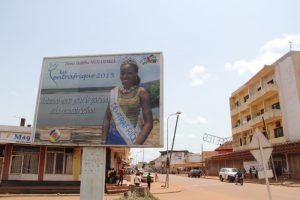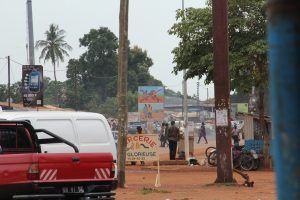Central African Republic: What Can We Learn From Civil War?
A reporter with a license to report should probably do some reporting. After only six weeks, I didn’t yet feel equipped to take on Kinshasa, a pretty unfathomable metropolis of more than 10 million. The political complexity, the mix of Machiavellianism and crude oppression, the relationship between the restless streets and the seats of power were still way beyond my grasp. I needed something unsubtle, something more event-driven, something where the sides were more clear-cut, something fewer rivals had already covered. The answer I came up with was the war in the Central African Republic (CAR). On the one hand, a horrifying conflict featuring both belligerents and victims; on the other, a curious country to which the majority of the world cannot point on a map.
What Happened In The CAR?
I spent most of May in northern Equateur, one of the DRC’s 11 provinces, and Bangui, the capital of the CAR, where I visited and interviewed numerous Central Africans who have been displaced by the fighting in their country. My writing on the conflict and its aftermath can be found here and here. However, as way of background, below is a wholly inadequate précis of what has taken place in the CAR in the past two and a half years.
In late 2012 a coalition of mainly Muslim armed groups formed an alliance called the Seleka which proceeded to sweep through the CAR from the north and east. The rebels reached Bangui in March 2013 and drove out the president, François Bozizé, who had led the country for a decade. The Seleka’s initial assault and subsequent rule were exceedingly cruel – and immensely unpopular in a country where 85 percent of the population are Christian and only 10-15 percent Muslim.
The anti-balaka, vigilante groups of Christians and animists, were suddenly provided with a higher purpose and their ranks swelled with young Central Africans, who seethed at the Seleka’s uninvited imposition. On 5 December 2013 Bangui erupted as the anti-balaka poured into the capital in the early hours to drive out the Seleka and depose the recently-installed Muslim president, Michel Djotodia. The Seleka’s brief ascendancy turned out to be disastrous for the CAR’s Muslims. Within several months of sickening sectarian violence the anti-balaka had vanquished the Seleka, who fled whither they had arrived, and secured the removal of Djotodia, who resigned under international pressure. They swiftly turned their attentions to emptying the CAR of Muslims altogether.
The anti-balaka nearly succeeded. In early 2014 a senior UN official warned that the ‘seeds are there for a genocide’ and a year later a UN commission of inquiry concluded that ‘ethnic cleansing of the Muslim population by the anti-balaka’ had taken place. Another UN report in June 2014 found ‘ample evidence’ that both sides had committed ‘crimes against humanity as well as war crimes’.
The bloodletting was incomprehensibly frenzied and merciless. Reporters and other observers have documented incidences of cannibalism, of gang rapes, of the decapitation of children, of the murder of babies. Lurid headlines reflected the difficulty outsiders experienced when trying to process what was taking place: ‘The hellish descent of the CAR’ (The Telegraph, 19/02/2014), ‘Are we ignoring Rwanda all over again?’ (The Guardian, 03/04/2014), ‘CAR cannibal: Why I ate a man’s leg’ (BBC, 13/01/2014).
In late 2013 France and the African Union deployed separate peacekeeping missions, the latter of which was taken over by the UN in September 2014. Today there are about 12,000 overseas military personnel in the CAR and they have helped bring about the uneasy peace which currently exists in the country. In May a forum attended by the interim government, the Seleka, the anti-balaka, civil society and religious leaders yielded a peace pact committing the combatants to ‘disarmament, demobilization and reintegration’. The content of the accord has been received positively in general and the emphasis has been on demanding the full implementation of its entire programme. The UN’s Secretary-General praised the ‘pact’s recommendations [for reflecting] the aspirations of the people of the CAR to put conflict behind them once and for all and to build a more peaceful and democratic country’.
Displacement And Putting The CAR Back Together Again
For what it’s worth here are my two cents: Mr. Ban’s fine words reflect that the forum did constitute meaningful progress. Indeed, I found that the accord was popular in Bangui, apparently with both Christians and Muslims; however, Mr. Ban is perhaps guilty of wishful thinking. He likely underplays just how comprehensively this already deeply dysfunctional state has been fragmented since late 2012 (when the Seleka went on the march) and in particular late 2013 (when the anti-balaka’s backlash tore Bangui apart).
What’s more, this fragmentation is both physical and psychological. The CAR is not a populous country. About 4.5 million people lived there when the conflagration started. For a country of this size the demographic upheaval which has occurred in recent years has been extraordinary. More than 5,000 have been killed, but nearly a million people have been displaced, either internally or in neighboring countries (particularly the DRC, Chad and Cameroon). While some are returning home – often to houses which no longer exist – most remain in limbo. Furthermore, the CAR’s Muslim minority was nearly purged in its entirety from the country. At the height of the violence in February 2014, Peter Bouckaert, Human Rights Watch’s emergencies director, stated, “At this rate… there will be no Muslims left in much of the CAR.” Most fled to Chad and Cameroon; peacekeepers were required to escort convoys of Muslims out of the country to keep them out of the hands of machete-wielding fighters; an unfortunate few stayed in the CAR imprisoned in enclaves from which it was a death sentence to stray.
This is not to say, however, that there are not many, many Christians who have been displaced by the war. Indeed, nearly all of the 95,000 Central Africans who have sought refuge in five UN camps in the DRC are Christians, and during 2014 the international airport in Bangui became a tarpaulin city temporarily housing more than 100,000 refugees, the vast majority of which were Christians. When I visited the airport last month I found fewer than 20,000 still living there. The majority have left heading for the burnt-out, stripped-down shells which used to be their homes, or a new place altogether.
It quickly became evident how profoundly the conflict has changed the way Central Africans see each other. The CAR’s Muslims and Christians have a long history of living, trading and studying together – and many Muslims I met in Bangui riffed nostalgically about their lives before December 5, 2013. Everyone I spoke to – Christian and Muslim – yearns for peace. Yet, understandably, trust is in short supply. The fighting in the CAR was not theological; it was not an argument over religious dogma or doctrinal interpretation. It was primarily political, concerning identity, about who rightfully belongs in the CAR, about the very definition of a Central African. The Seleka was backed by mercenaries from Chad and Sudan – and likely received financing from Muslim countries. As such, its unwelcome arrival in Bangui in March 2013 was widely viewed as a foreign invasion.
As the conflict divided along increasingly sectarian lines and mixed communities became a thing of the past, more and more Christians came to see all Muslims as synonymous with the Seleka – which was wildly unjust – and to re-imagine a CAR which is exclusively the domain of Christians and animists. Adjectives such as “pure,” “real” and “true” litter the conversations of Christians when talking of nationhood and citizenship.
Conversely, terrified Muslims noticing and witnessing this transformation in the majorities’ attitudes have come to suspect that every Christian wishes them dead or exiled. The resulting atmosphere – at least in the communities I visited – is one in which almost everyone acknowledges that the majority of Central Africans never lifted a finger in anger against their compatriots of a different religion. But no one has much faith in the capacity of Muslims and Christians to live side by side in peaceful coexistence. I met Christians who suspect Bangui’s remaining Muslims of stockpiling caches of weapons. I found Muslims who think they’ll be hacked to pieces if they leave their sanctuaries. The civil war has traumatised Central African society. The wounds may not be fatal but they have left it harder, paranoid and unforgiving.
While I was reporting from Bangui and the camps of northern DRC I took plenty of photographs. Some of them (I hope) convey in some infinitesimally small way what it might feel like – the rage, the powerlessness, the resourcefulness – to be displaced from one’s home. Some of these images are below:![]()
Miss Central Africa 2015 echoes the message of peace and reconciliation
Bangui’s M’poko International Airport: Once home to around 100,000 refugees, now fewer than 20,000
A billboard campaign financed by the UK and US government encouraging the CAR’s Muslims and
Christians to put down their weapons and be friends
By William Clowes – William is a freelance journalist based in Kinshasa, the Democratic Republic of Congo. Previously he was a sub-Saharan Africa analyst at The Risk Advisory Group, a political risk and commercial due diligence firm headquartered in London.



